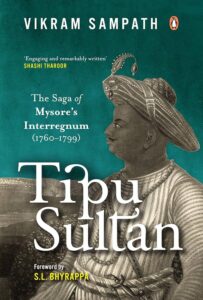Tipu Sultan, known as the “Tiger of Mysore”, ruled the southern Indian kingdom of Mysore from 1782 to 1799. Born in 1750 to Haidar Ali, a military leader who gained power through strategic alliances, Tipu inherited a strong state during colonial upheaval. He led Mysore to prominence, fighting the British East India Company in the Anglo-Mysore Wars, and died heroically in 1799 defending Srirangapatna. Tipu stood out for his innovations and controversies. He boosted the economy with silk and trade reforms, introduced a new calendar and coins, and developed iron-cased rockets that impressed British forces. He even sought alliances with Napoleon and the Ottoman Empire to counter British rule. However, his legacy splits opinion: hailed as an anti-colonial hero, he’s also criticized for forcing conversions and destroying religious sites in Malabar and Kodagu, sparking debates over his tolerance versus tyranny.
Vikram Sampath’s substantial new book dives into this turbulent era, aiming to present Tipu “as he was, warts and all,” without the gloss of legend or the stain of outright condemnation. Rather than a straightforward cradle-to-grave biography, this book excavates Tipu Sultan’s tangled legacy, cutting through centuries of both hero-worship and vilification to reveal the figure behind the legend. As Sampath himself puts it:
In this book, Tipu emerges for me as a complex character and a historian’s enigma—one who defies easy compartmentalization. The good, the bad and the ugly in Tipu Sultan’s legacy emerge.
The Tiger of Mysore’s favourite toy was a mechanical tiger mauling a British soldier, complete with growls and shrieks.

There is a moment, early in Tipu Sultan: The Saga of Mysore’s Interregnum, when the author describes the Tiger of Mysore’s favourite toy—a mechanical tiger mauling a British soldier, complete with growls and shrieks. It is a chilling, almost childish spectacle. But Sampath, a careful historian, shifts our focus to the bigger picture behind it: of a man who was both visionary and vandal, patriot and parochialist, a ruler who dreamed of expelling the British even as he sought to expand his own dominion.
A central theme of the work is the stark contrast between Haidar Ali and his son, Tipu. Haidar is portrayed as a “Machiavellian ruler” and a “shameless opportunist” who, while ruthless, maintained a certain “tact” and “diplomatic balance” with the Hindu majority. Tipu, in comparison, is shown to have dangerously upset this balance with his “foolhardiness on matters of faith” and his “overbearing influence” of religion on his rule. The establishment of his theocratic state, “Sarkar-e-Khudadad”, and the widespread conversion of non-Muslims leave little doubt about his agenda. Sampath notes that “the twentieth century remade Tipu into both hero and heretic, depending on who was narrating him.”
The book’s greatest strength lies in its refusal to flatten.
The book’s greatest strength lies in its refusal to flatten. Tipu’s wars against the British are not romanticised as anti-colonial resistance; they are shown as strategic calculations, often indistinguishable from his wars against the Marathas. While his famed rocket artillery is celebrated, his scorched-earth policy in Malabar,“where Sampath records widespread violence and coerced conversions among the Nairs” remains a dark and condemned aspect of his legacy.
Sampath does not flinch. He quotes Persian chronicles, English dispatches, and Kannada folk songs, letting their narratives remain in contestation with one another. Sampath delves into primary records, including “The Dreams of Tipu Sultan”, a series of personal papers that offer an unfiltered glimpse into the Sultan’s mind. These documents, penned in Farsi, reveal a ruler driven by religious fervor and expansionist ambitions, “often referred to his adversaries, Hindus as kafirs and British as Christians, reflecting the religious vocabulary of the time.” Sampath does not shy away from uncomfortable truths; instead, he directly confronts the “blood-thirsty and cruel side to Tipu, whose religious zeal and expansionist dreams” led to mass conversions and the desecration of religious sites.
Yet, Sampath is no revisionist. He does not invert the myth only to replace it with a mirror-image demon. Tipu’s administrative reforms, his attempts at modernising the army, his curious experiments with the Mauludi calendar, all are given their due. Even his religious policy, often caricatured as mere persecution, is shown to be instrumental rather than ideological, a tool of statecraft, not theology. The irony, Sampath suggests, is that Tipu’s greatest crime was not intolerance but ambition, an ambition that outran his resources, his alliances, and ultimately, his time.
Tipu Sultan is a monumental act of historical restoration.
At 900 pages and 20 chapters, the book is unapologetically maximalist, and there are moments when the narrative sags under the weight of its own detail, while chronology occasionally loops back on itself. And Sampath’s prose, while generally crisp, sometimes veers into the purple, especially when describing battles, where cannonades become a “thunderclap of destiny”.
But nevertheless Tipu Sultan is a monumental act of historical restoration, not of a hero, not of a villain, but of a man who was both, and neither. In an age when history is fought over like a frontier province, Sampath has done something rare: reclaimed the past from the present. Tipu Sultan, in these pages, is not a statue to be garlanded or defaced, but rather a ghost, still prowling the corridors of our collective memory, half-tiger, half-man, wholly unresolved. In the end, Tipu emerges not as a nationalist martyr or religious despot, but as what Sampath calls “a sovereign at the edge of two centuries, carrying the burden of both.” And perhaps that is the most honest epitaph a historian can offer.


You must be logged in to post a comment.